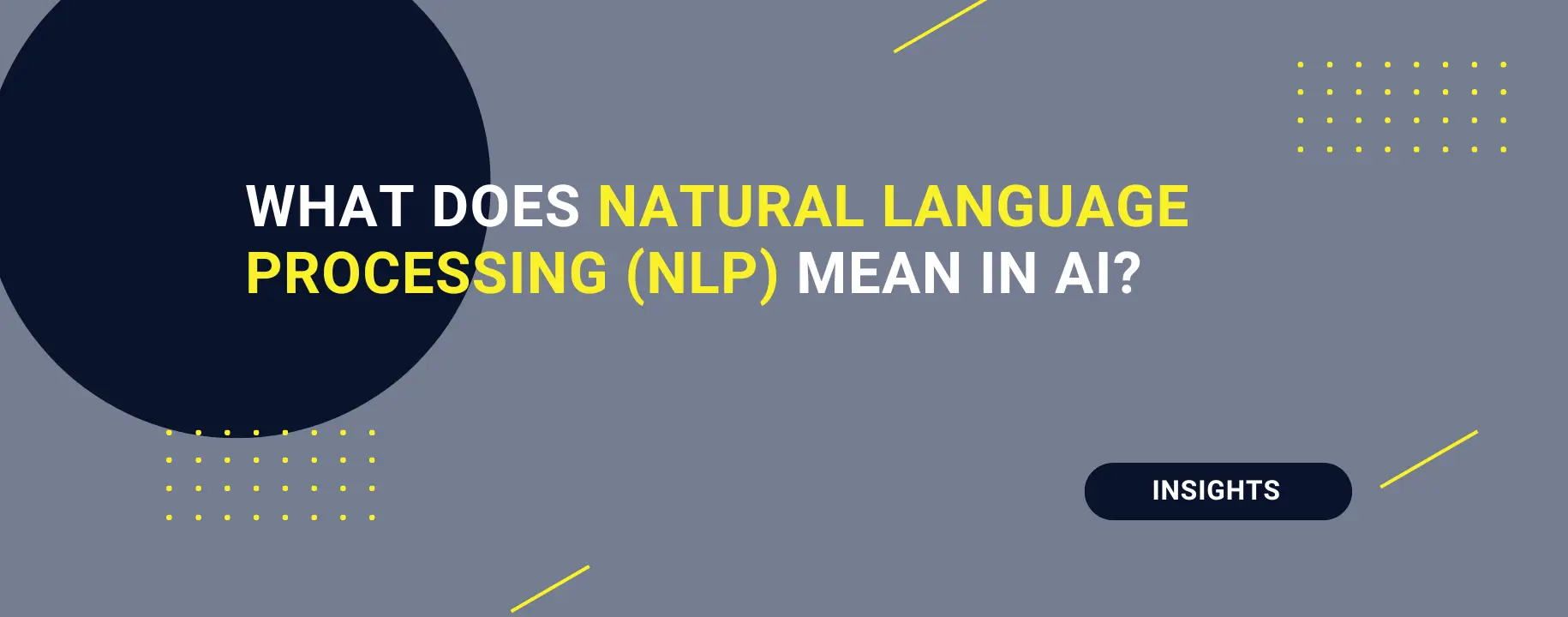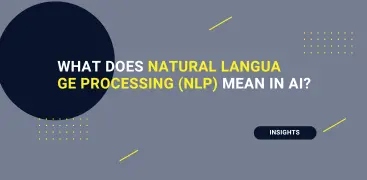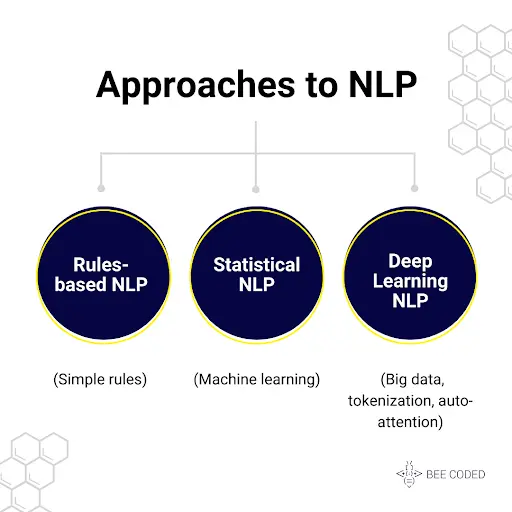- For developers
- Industry insights
- People in tech
- Tech trends at BEECODED
- 9 Apr 2025
What is natural language processing (NLP)?
These days, we all raise an eyebrow when we hear about artificial intelligence (AI).



Table of contents
Contributors

What is NLP in the artificial intelligence (AI) world?
These days, we all raise an eyebrow when we hear about artificial intelligence (AI). This vast and complex field includes several specialized branches, each with its own role. One of the most fascinating is NLP (Natural Language Processing).
NLP is part of generative AI and refers to a machine’s ability to understand, interpret, and generate human language (written or spoken).
This is how assistants like Siri, Alexa, and Cortana can answer our questions and help us make a call or set an alarm. NLP also plays an important role in machine learning, because it helps it to learn from huge amounts of text data and improve its answers over time.
Read our article and find out everything you need to know about NLP!
NLP use cases and benefits
Sometimes it’s really hard to believe you’re not talking to a real person. And that’s because NLP makes it possible to communicate with machines in a natural language, used in everyday life. This offers many benefits across a variety of industries:
- Streamlining repetitive processes
- Data analysis
Optimized search capabilitieses
NLP is very useful in automating routine tasks such as customer support, data entry, and document handling. For many people, a high volume of routine tasks can lead to frustration and, therefore, errors. By automating these processes, NLP saves time and allows people to focus on other tasks.
Data analysis
NLP extracts insights from unstructured text data, such as customer reviews or social media posts. Using text mining techniques, NLP identifies patterns, trends and sentiment in large datasets. Sentiment analysis detects emotions and attitudes in text (like enthusiasm, sarcasm, or an aggressive tone), which helps businesses understand customer preferences.
Optimized search capabilities
NLP improves search by allowing systems to understand the user’s intent and not just the keywords they type. For example, even if you ask something in vague terms, the system will understand what you’re looking for and give you results that make sense, even if the question isn’t worded perfectly.
Content creation
We’ve all heard of (and use) chatGPT. This is an advanced language model that can generate human-like texts for various purposes. Pre-trained models such as GPT-4 can create articles and creative texts based on suggestions they receive.
Client assistance via chatbots
Chatbots are used in customer service and help people by answering inquiries in natural language. These chatbots are available 24/7, thus reducing costs and allowing employees to focus on more complex issues that chatbots cannot handle.
Real-time language translation and adaptation
NLP breaks down communication barriers all over the world with real-time language translation. These tools maintain context and meaning across languages, adapting to regional dialects and cultural nuances.

Approaches to NLP
NLP combines computational linguistics, which deals with the study of human language and its rules, with machine learning algorithms, which allow systems to learn from data and improve their performance, and with deep learning, an advanced learning method that helps analyze large amounts of data to better understand language and context.
Rules-based NLP
The earliest NLP applications used simple if-then decision trees with preprogrammed rules. These systems could only answer very clear questions and could not understand more complicated language. Essentially, you would tell them exactly what to do, and they would simply execute that, without any deeper understanding.
Statistical NLP
Statistical NLP analyzes texts and records probabilities for what certain words or phrases might mean. It uses machine learning to better understand what people say and to identify relationships between words.
Deep learning NLP
Deep learning models are the most advanced and use lots of data (texts or conversations) to understand language more precisely than ever before. They use techniques like tokenization (splitting a text into smaller parts) and auto-attention (helping to understand the relationships between different parts of a text). These technologies help systems understand human language much better, even when it is more complex.

NLP employs a number of methods to enable computers to comprehend natural language. The process involves two main phases: data preprocessing and algorithm development.
I) DATA PROCESSING
At this point, the computer gets the text ready for your comprehension. This implies:
- Tokenization: this is the process of dividing text into smaller units, like words or sentences.
- Stop word removal: this one refers to eliminating words like “and” that don’t contribute much information.
- Lemmatization and stemming: these are the processes of breaking down words into their most basic forms (for example, “better” becomes “good” in stemming, or “running” becomes “run” in lemmatization).
- Part-of-speech tagging: declaring each word’s function in the sentence (such as whether it is a verb, noun, etc.) is known as labeling parts of speech.
II) DEVELOPMENT OF ALGORITHM
After the text is ready, the computer analyzes it and determines its meaning using specialized software (algorithms). After that, it can produce text or respond in a manner akin to that of humans.
Most common NLP tasks
NLP includes a number of specialized tasks:
- Recognizing when two terms refer to the same thing is known as coreference resolution.
- Named entity recognition is the process of recognizing and categorizing entities, such as names of people, places, and organizations.
- Assigning grammatical categories to words is known as part-of-speech tagging.
- Word sense disambiguation is the process of identifying a word’s meaning when it has several meanings.
Challenges of NLP
Despite its advancements, NLP continues to face challenges. Below is a summary of them:
- Biased training: Systems may incorporate human biases in training data.
- Misinterpretation: It’s still challenging to understand idioms, sarcasm, and humor correctly. But artificial intelligence is advancing swiftly, and these systems will soon be able to comprehend linguistic nuances much better.
- New vocabulary: Language must be updated because it is constantly evolving.
- The tone of voice: Written texts lack vocal cues that help readers understand the emotional context.

NLP programming languages
There are several programming languages used for NLP development, such as:
Python
Python is the predominant programming language in NLP development, due to its simplicity and libraries (such as NLTK, spaCy, and Transformers)
Java
Java is used in enterprise-level NLP applications because it can handle large volumes of data (scalability) and integrates easily with other existing systems, making it ideal for large-scale and complex solutions.
C++
C++ is used in applications that need to run very fast and consume as little memory as possible. For example, in NLP applications that need to respond immediately (in real time), C++ is useful because it helps to get a fast response without consuming too much computer resources.
Evolution of natural language processing (NLP)
Natural language processing began in the 1950s, when Alan Turing proposed the Turing test, which assessed a machine’s intelligence by its ability to understand and generate human language.
Symbolic NLP: years 1950 -1990
In the beginning, NLP relied on simple rules to understand language. In the 1950s, the first experiments with machine translation took place, but progress was slow. The 1960s and 1970s saw the first systems that interacted with language, such as ELIZA (a program that simulated a psychotherapist). In the 1980s and 1990s, research focused on more advanced rules for analyzing language (semantics, morphology etc).
Statistical NLP: years 1990 – Current days
Since the 1990s, natural language processing has evolved thanks to machine learning algorithms. These algorithms learned to process language based on examples, not just fixed rules. At the time, research was successful in machine translation, and as the internet grew, more and more data was used to improve NLP technologies.
Today, NLP technologies use advanced neural networks to understand and generate human language more accurately, and are used in all kinds of applications, from machine translation to document analysis in a variety of domains.
Where is NLP heading these days?
As technology advances rapidly, natural language processing (NLP) is expected to become even more accurate and versatile, transforming the way we interact with computers and opening up new possibilities in all fields.
Explore our blog articles and discover more about AI and NLP! Learn how these innovative technologies can transform your business and improve your processes, efficiency and customer interaction!
12 Natural Language Processing techniques used to process text by data scientists
What is natural language generation? (NLG)
Money in Motion: First App to Integrate Open Banking for All Romanian Banks and Revolut, Partnered with Finqware